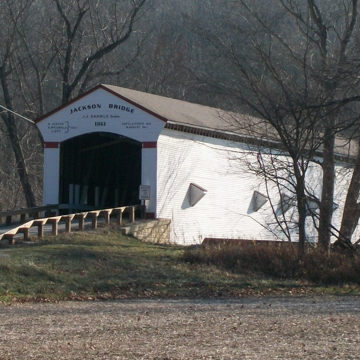You are here
Jackson Covered Bridge
The Jackson Bridge over Sugar Creek represents an outstanding and nationally notable collection of covered bridges in Parke County. As many as 58 covered timber bridges were constructed in the county from 1847 to 1920, with 31 still standing. Jackson Bridge, with double Burr arches, is the longest single-span example at 207 feet in length. Parke County has been celebrating its tradition as the “covered bridge capital of the world” since 1957 with the Covered Bridge Festival, which attracts millions of visitors to this rural West Central Indiana county each summer.
Immigrants brought the covered bridge building tradition to the Midwest, where timber bridges were used from the 1810s to the 1920s. Engineers quickly learned that open wooden structures only lasted 10 to 20 years, but when covered and properly maintained those same structures could stand for decades longer. Ten engineers designed and built timber bridges in Parke County in the nineteenth century. One of the most prolific builders was J. J. Daniels, who built about sixty bridges in his career, including the Jackson Bridge. Born in 1826 in Marietta, Ohio, Daniels’s father was an agent for Stephen Long, a bridge engineer who developed the Long Truss. Daniels assisted his father and then started his own firm; he built his first span in Parke County in 1851.
The Jackson Bridge is an example of Burr arch structure, a truss system patented by Theodore Burr in 1804 that became common in the Midwest in the nineteenth century. An innovation on existing arch truss systems, the design uses wooden arches attached to multiple king posts. It is strong enough to span long distances and was the first patented design to gain widespread use by bridge builders. The Burr arch system was preferred by Indiana’s builders and county commissioners because of its low cost, strength, and durability. Most of Parke County’s covered bridges use this design. The Jackson Bridge is somewhat unique, as it uses a double Burr arch, with arches appearing on both sides of the trusses.
The Jackson Bridge underwent an extensive restoration in 1977. The floor system runners, floor boards, swag bracing, floor beams, and abutments were all repaired. The structure was restored again in 2009. Today, the Jackson Bridge is the longest single-span wood truss bridge that is still open to vehicular traffic.
References
Christianson, Justine, et al., eds. Covered Bridges and the Birth of American Engineering.Washington, D.C.: National Park Service, Historic American Engineering Record, 2015.
Felkner, Charles, “Parke County Covered Bridge Historic District,” Parke County, Indiana. National Register of Historic Places Inventory–Nomination Form, 1977. National Park Service, U.S. Department of the Interior, Washington, D.C.
Sinclair, Stan. Illustrated Guide to Parke County Covered Bridges. Self-published, 1991.
Writing Credits
If SAH Archipedia has been useful to you, please consider supporting it.
SAH Archipedia tells the story of the United States through its buildings, landscapes, and cities. This freely available resource empowers the public with authoritative knowledge that deepens their understanding and appreciation of the built environment. But the Society of Architectural Historians, which created SAH Archipedia with University of Virginia Press, needs your support to maintain the high-caliber research, writing, photography, cartography, editing, design, and programming that make SAH Archipedia a trusted online resource available to all who value the history of place, heritage tourism, and learning.








